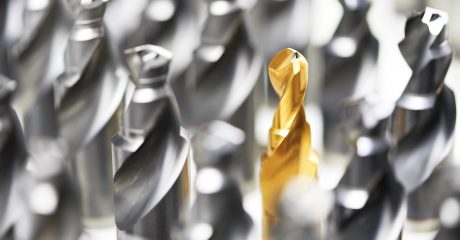Cutting tools come in many shapes and sizes. Picking the right one for a specific task can be difficult. With a variety of styles to choose from, the matter is further complicated when you must consider what coating would be best for that tool.
At that point you might be questioning if the coating matters–surely it’s not that big of deal, right?
Wrong, it pays to understand how tool coatings make a difference.
Coating Characteristics
Each of the following characteristics plays a major role in determining which treatment is the best for certain applications.
Hardness: Generally speaking, the harder the coating, the longer the tool will last–it’s one of the best ways to increase the life of a tool. Out of the more common coatings, Titanium Carbo-Nitride has a higher surface hardness than Titanium Nitride. The addition of carbon increases hardness by 33 percent and changes the range from about 3,000 to 4,000 Vickers.
Wear Resistance: This is the coating’s ability to protect against abrasion. A tool may not be that hard on its own, but with a solid coating it could be protected and reinforced. Coatings like these are beneficial, especially because there are elements and processes during production that can cause the breakdown of cutting edges.
Surface Lubricity: High amounts of friction cause an increase in temperature, leading to a shorter coating life and sometimes coating failure. The amount of heat can be reduced by a surface that lacks irregularities. These slick or smooth surfaces allow the chips to slide off the face of the tool. Additionally, a higher surface lubricity allows for increased speeds when compared to non-coated versions.
Oxidation Temperature: This is the point at which the coating starts to break down. A higher temperature rating improves success in high heat applications. For example, Titanium Aluminum Nitride coatings may not be as hard as Titanium Carbo-Nitride at room temperature. However, Titanium Aluminum Nitride proves to be much more effective in applications where heat is generated. It holds its hardness at higher temperatures due to a layer of aluminum oxide that transfers heat away from the tool and into the cutting chip.
Common Types
There are two basic kinds of coatings: Physical Coatings and Chemical Coatings. Physical coatings, or PVD coatings work well at lower temperatures and are usually thinner. Chemical Coatings, or CVD coatings are applied at extremely high temperatures–around 18000° F. This results in a very strong and even coating that holds up well to high temperatures.
Most are familiar with the old standby coatings, but not with the relative newcomers. So, here are the top 5 most common coatings:
Titanium Nitride (TiN): TiN coatings are gold in color. This is the most commonly used coating because the ceramic base is hard and heat resistant.
Titanium Carbonitride (TiCN): TiCN coatings are harder than TiN, and they create less friction with most materials.
Chromium Nitride (CrN): CrN coatings are silvery and metallic in color. These offer similar benefits of TiCN, but CrN can get hotter and still maintain its innate qualities.
Aluminum Titanium Nitride (AITiN or TiAIN): These coatings are normally dark gray in color. They’re normally used when the job is too hot for TiN coated tools, because they are harder and can maintain their hardness at higher temperatures.
Titanium Aluminum Carbonitride (TiAICN): TiAICN coatings are the easiest to recognize due to their pink or rose-colored appearance. This is a nano coating, which means it’s extremely hard, and is resistant to high temperatures and still yields low friction.
Coatings are Key
There’s much more to tool coatings than a bunch of obscure chemical compounds. Good carbide is important, but a good coating on the surface of that carbide is critical. Moreover, the method used to apply the coatings is equally important.
Of course, coating technology has changed greatly. Anyone who’s shopping for a cutting tool has most likely noticed the higher price tags that come with these new advanced coatings. But at 2 to 3 times the price of “standard” tool coatings, is it worth it?
The short answer–of course! While potential performance increases depend on a wide range of variables, it’s safe to say increased productivity and extended tool lifespan will certainly result in a net reduction in overall costs.
Contact Custom Tool & Grinding
Tool coatings aren’t just for show. From keeping your tools sharp to holding onto lubricant, coatings are extremely useful. To determine which coating will work best for you, contact us today for a consultation. You’ll be glad you did!
